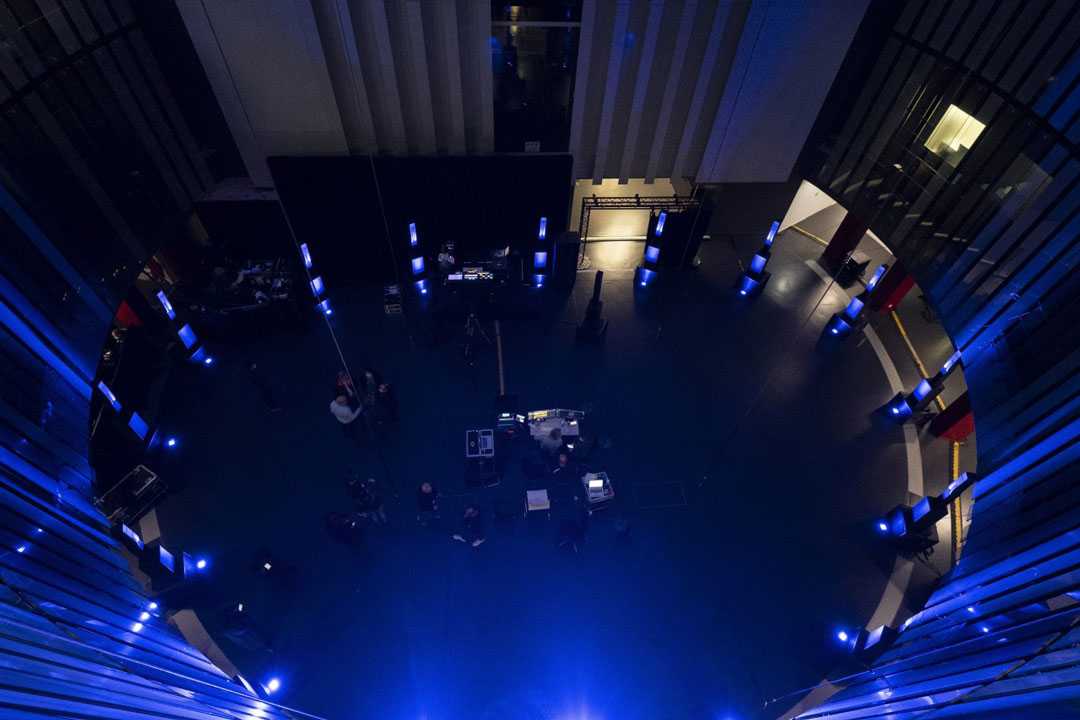Jean-Michel Jarre’s Oxymore goes live with BroaMan & Optocore
- Details

Planned as a homage to pioneering electronic musician, Pierre Henry, who had bequeathed a series of sounds to Jean-Michel Jarre during his lifetime, Oxymore a brand new musical creation by Jarre, was performed twice daily across three days. It was broadcast and live VR streamed to tens of thousands of viewers, while audiences of 250, immersed in the 360° space, witnessed it live.
The event followed his successful Welcome to the Other Side Notre Dame Cathedral VR experience, which took place last New Year’s Eve during lockdown. The Radio France live performances were broadcast via radio and streamed in 6DoF binaural format to the virtual platform VRChat - from ‘metaverse architects’ VRrOOm / XR Studio, where the giant 3D city was populated by avatars.
The immersive 17.2 sound system, designed by system engineer Christophe Dupin and Radio France’s innovation audio project manager and immersive specialist Hervé Déjardin, was based around the L-Acoustics L-ISA immersive sound, and the SPAT spatialisation suite he helped to design, with all distribution taking place over a BroaMan / Optocore fibre backbone, provided by Gilles Bouvard’s GB4D. “The technical request from Radio France for this operation required a lot of preparation,” notes Bouvard. “François Lund assisted with the set-up and development of this network and Harmony Network helped with the design.”
Déjardin had been closely involved in that immersive mix for Jarre’s earlier Notre Dame concert, during which the two men spent a lot of time discussing how to best ‘spatialise’ Jean-Michel’s compositions. They debated how it could be taken further.
The plan - immersive audio design and idea for VR streaming - started to take shape. According to Déjardin, when he was looking for a signal distribution system he consulted with sound engineer colleague Christian Lahondes, who managed the broadcast for the VR. “He said why not Optocore? We’ve had good experiences with this in the past and it’s versatile and an open protocol platform - so we could transmit video.”
The sound materials dovetailed beautifully with the new composition of Jean-Michel Jarre as Hervé Déjardin, who spatialised and mixed the sound, explains. “We first started speaking about this project back in September 2021. He started to compose quickly and in six weeks he had 11 tracks - 55 minutes of music. We had a lot of exchange of info along the way and discussed many ways to experiment in space.”
Gilles Bouvard has collaborated many times with Radio France and Hervé Déjardin in the past and again produced an ingenious network topology, with a bespoke multi-stream design.
“This large BroaMan / Optocore Luminex Gigacore system is the heart of the system and carries all signal transport, including many MADI streams,” he explains. “Broaman allowed us to build the backbone of the entire system: MUX22 MADI for video with Com Optocore, and the 1310 nm tunnels allowed the connection of Luminex Gigacore 14R for Dante, OSC and basic LAN.”
With more than 600 audio inputs in the Optocore network several important parameters had to be managed: Global sync; Timecode; Mic preamps; OSC commands; video for studios in 3G SDI; IP link; interface between the DiGiCo and L-Acoustics devices; Dante (for some of the computers); video in and out and Intercom, and distribution of the live signal feed in Binaural audio on France Musique.
Deployment of a five-way Route66 AutoRouter enabled Optocore distribution in multiple directions, while a Broaman Route66 (for video) also allowed signals to be distributed in several directions, and gave COM ports for the Luminex star network from a Gigacore 26i.
Explaining this topology Bouvard states: “The basic principle was that the BroaMan backbone could transport everything including video, while Optocore was used for sync, audio in/out and timecode. Luminex was deployed for Dante, IP and Open Sound Protocol (OSC) via BroaMan tunnels.”
The Open Sound Protocol was ideal for networking the metadata for this object based audio project between different processing renderers.
In conclusion Déjardin, says: “Jean-Michel had wanted to work with the immersive teams of Radio France.
“You don’t have a chance to use these tools every day, it was an excellent learning experience. I prepared for two months ahead, even developing some special tools for this work, and working very closely with Jean-Michel, as he composed and produced Oxymore specifically for the immersive audio experience. He knew exactly how it should sound.
“Thanks to all the preparation everything was perfect. The concert was exceptional and really achieved the wow factor we were looking for.”
In conclusion Gilles Bouvard adds: “It was a real task and a recognition of quality to have Radio France's total confidence in this important concert by Jean-Michel Jarre. Once again BroaMan and Optocore allowed us to rise to this magnificent challenge.”
















